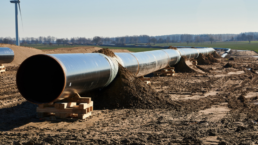Russia’s $11 billion natural gas conduit to Germany is a by-product of Donald Trump’s pro-Putin foreign policy—and a real headache for President Biden.
By Marianne Lavelle, Inside Climate News
As tensions simmer on the Ukraine-Russia border, the Nord Stream 2 pipeline has become an emblem of the energy and climate issues underlying the conflict—even though it has yet to deliver a molecule of natural gas.
Last week, the U.S. State Department vowed that Gazprom’s $11 billion conduit beneath the Baltic Sea to Germany would never open if Russia invades Ukraine. Much of eastern Europe, the environmental movement and even the U.S. oil industry opposed Nord Stream 2 as a tie designed to solidify Russia’s energy hold on Europe, but Russian President Vladimir Putin took advantage of leeway offered by President Donald Trump to push construction through.

Trump’s tacit acquiescence on Nord Stream 2 (often while voicing protest) was one of his only moves counter to the interests of Texas oil and gas producers, who coveted the Europe gas market themselves. But it was right in line with two other Trump impulses: to reject climate policy and to yield to Putin.
Now, the Biden administration is left with the consequences. And although it is attempting to use Nord Stream 2 as a threat, the pipeline also has served as a weapon for Putin—a wedge to divide Germany, and separate Europe’s largest economy from other members of the NATO coalition while he threatens Ukraine.
Whatever happens next as 127,000 troops encamp on Russia’s western frontier, the conflict already bears the imprint of Trump’s climate denial, Putin’s drive to maintain Russia’s fossil-fueled power and the slow pace of global transition to clean energy. In other words, it’s a textbook example of how climate change is amplifying foreign policy perils, said Erin Sikorsky, director of the Center for Climate and Security think tank in Washington, D.C.
“Climate is unlikely to be the sole driving force of a geopolitical confrontation or competition, but it will intersect with other existing risks and challenges in such a way that it shapes the environment,” she said.
Recent Posts
‘Unconstitutional. Unethical. Authoritarian.’ ICE Bars Millions Of Immigrants From Bond Hearings
July 18, 2025
Take Action Now One watchdog said the new policy “seems like a blatant attempt to stop them from exercising their right to due process.”……
Americans Are Not Nearly Alarmed Enough About Climate Change
July 18, 2025
Take Action Now Americans still don’t comprehend how imminent, dangerous, and far-reaching the threat is—and journalists are partly to blame.By…
The IRS Is Building A Vast System To Share Millions Of Taxpayers’ Data With ICE
July 17, 2025
Take Action Now ProPublica has obtained the blueprint for the Trump administration’s unprecedented plan to turn over IRS records to Homeland Security…
Israel’s Sudden Assault On Syria Is Unchecked Aggression
July 17, 2025
Take Action Now Jerusalem is bombing Damascus and threatening al-Sharaa’s rule, while Washington was hoping to help the nascent government on…




